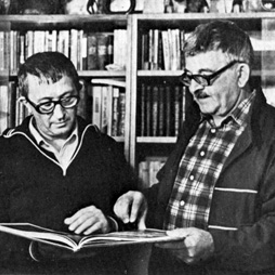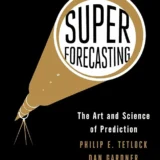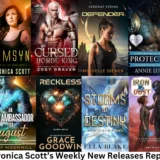 Growing as a punk rocker and thrash metal in the pre-internet/Nirvana era meant that the act of discovery was something more profound. There were no internet rabbit holes, no fans of Ender’s Game also liked this or that book. The method of discovering bands came from magazines like Maximum Rock N’ Roll and often the thanks list on albums. When I hang out with older punks or hardcore scenesters I always ask how they discovered the music because it is always interesting.
Growing as a punk rocker and thrash metal in the pre-internet/Nirvana era meant that the act of discovery was something more profound. There were no internet rabbit holes, no fans of Ender’s Game also liked this or that book. The method of discovering bands came from magazines like Maximum Rock N’ Roll and often the thanks list on albums. When I hang out with older punks or hardcore scenesters I always ask how they discovered the music because it is always interesting.
The discovery process for the golden age and new-wave science fiction authors is also interesting. For many of them like E.E. Smith the author of the Skylark of Space Series that appeared in some of the earliest issues of this magazine the name Science Fiction had not even been coined. Thanks to the internet archive we can look at many of these issues that were the first introduction for major voices in the genre.
This is not a complete list, just some I happened upon.
EE Smith: He started reading Argosy in 1915, he loved H.G. Wells, Jules Verne, and Edgar Rice Burroughs, but there is not one piece that Smith pointed to. In 1915 Argosy published complete novels in the pages and did twelve issues for fifteen cents an issue.
Isaac Asimov: A child of Russian immigrants who owned a Candy store in Brooklyn Asimov has access to pulp magazines that his father sold in the store. The pulps in his father’s candy store were free for Asimov but his father often censored what he could read. It was Amazing Stories August 1929 that was his first issue when he was nine years old. This issue doesn’t contain a ton of classics but features the first serial of Leslie F. Stone’s serial Out of the Void. The cover story is Barton’s Island by Harl Vincent.

Ray Bradbury: His Mother read OZ books to Bradbury before he could read, and as he learned he was allowed to read Edgar Allen Poe. His introduction to the genre came in the Fall 1928 issue of Amazing Stories Quarterly which was randomly handed to him by a teenage girl as the family boarded a train. The issue included The World of the Giant Ants (serial) by A. Hyatt Verrill. Between 1932-34 the family briefly lived in Arizona and young Ray had a friend who had multiple issues of Thrilling Wonder Stories and Amazing Stories.

John W. Campbell: The famous editor just discovered Edgar Rice Burrough’s Tarzan and John Carter when he claimed to start reading Argosy at seven years old. He also claimed to read Weird Tales and Amazing Stories from their first issues. When he was 18 (1928) on summer vacation he kept hitting up the newsstands looking for Skylark of Space by EE Smith in Amazing Stories. That would have been the August issue that also featured Armageddon—2419 A. D. by Philip Francis Nowlan the first appearance of Buck Rodgers.
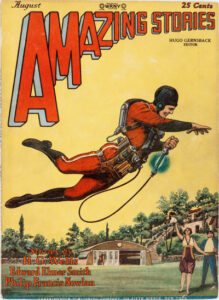
Fredrick Pohl: According to his memoir The Way the Future Was, his first encounter might have been in the first issue of Science Wonder but it was in 1931 when ten-year-old Pohl found a four-year beaten-up copy of Amazing Stories Annual 1927 in the attic of his house. It featured Edgar Rice Burrough’s The Master Mind of Mars. He started hunting down pulp Magazines from there.

Philip K. Dick: When 12 years old Phil was looking for Popular science and bought one of four issues of Stirring Science Stories (it wasn’t published long but edited by Don Wollheim who would buy his first novel in 1954) I believe it was the April issue and Includes two stories by Cyril M. Kornbluth under his “S. D. Gottesman” and “Cecil Corwin” pseudonyms and stories by Donald A. Wollheim (called !!!), James Blish, Damon Knight, Clark Ashton Smith, and others.
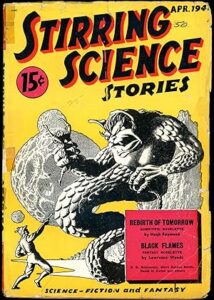
Gene Wolfe: “The first [sf] story I read was ‘Microcosmic God’ by Theodore Sturgeon. It has sometimes occurred to me that it has all been downhill from there.” It first appeared in the April 1941 issue of Astounding. Wolfe would have been ten years old when this issue (also featuring stories by AE Van Vogt and L. Ron Hubbard) was first published.
Leigh Brackett: She was raised in Santa Monica, her father died when she was three years old. She discovered science fiction by reading Edgar Rice Burroughs’ The Gods of Mars “on or about” her eighth Birthday December 7, 1923. It was first published in The All-Story weekly pulp magazine as a five-part serial in the issues for January–May 1913. It was later published as a complete novel in September 1918. It was likely this stand-alone she was given as a birthday present.
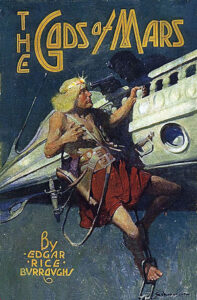
Edmond Hamilton: Brackett’s husband had a similar story although he was a decade older. Convinced that he was a genius Hamilton started high school at age ten, and graduated high school at age 14 with no difficulty. He was at Westminster College at age Fifteen. He first read A. Merrit and Edgar Rice Burroughs at fifteen years in All-Story Magazine and Argosy.
Damon Knight: Grew up in Hood River Oregon, the son of the principal of his school, at ten years old he had read his way through the library when he found the Amazing Stories August-September 1933 issue. It features The Meteor-Men of Plaa by Henry J. Kostkos. Soon he was tracking down pulp magazines on trips to Portland with his family.

John Brunner: When he was eight years old at the start of the Second World War, Brunner’s family moved back to his Grandfather’s farm in Brimfield, Herefordshire. Shortly after the move his Grandfather’s rare 1898 edition of HG Wells’s The War of The Worlds was accidently shelved in his playroom. He read it, and then The Time Machine before being given a copy of The Clipper of the Clouds by Jules Verne for
Anthony Boucher: Born in Oakland in 1911, his father died when he was less than a year old. Boucher suffered from asthma as a child. Like many authors on this list he was frequently bedridden and became a voracious reader, often citing Arthur Conan Doyle. Boucher’s first science fiction work was Ye Goode Olde Ghost Story, which was published in Weird Tales in January 1927 under his real name, William Anthony Parker White, when he was just sixteen years old.
Donald A Wollheim: When he was thirteen years old in 1927 he found a copy of The War of the Worlds at the public library. Soon after he was given a copy of Amazing Stories. He would go on to be the first editor to put the name Science Fiction on the cover of a book, and become one of the most important editors in Science Fiction
Murray Leinster: Published his first story Runaway Skyscraper in Argosy in 1919, seven years before Hugo Gernsbeck popularized the term Science Fiction. He was too poor to finish high school or attend college. During WWI, he served on the Committee on Public Information in the Army. I have not found any evidence that points to his first contact but it appears he loved to read Argosy.
Walter Tevis: He was Born in San Francisco, in 1938 at the age of ten his parents placed him in the Stanford Children’s Convalescent home and they returned to Kentucky, where the Tevis family had moved from. Walter traveled across the country alone by train at the age of eleven. The first evidence we have that he discovered Science Fiction is a Letter he wrote to review an issue of Fantastic Adventures, the letter appeared in the March 1941 issue.
Samual R. Delany : At the Vassar Summer Institute for Gifted Children, Delany read a newspaper with one of William Donohey’s illustrations from his weekly series, The Teeny-Weenies, which his mother had just been reading him, Eventually he credits a Gil Kane Batman comic book as the first text he read on his own. He often still cites Alfred Bester and Theodore Sturgeon as influences.
Jack Williamson: Author of the Legion of Space series. He dropped out of high school to work on the family farm. His friend Eddie Walker was into ham radio and subscribed Hugo Gernsbeck’s Radio News, he was given a free copy of the March 1927 issue of Amazing Stories which he passed on to Williamson. The issue featured Under the Knife by H.G. Wells, The Land that Time Forgot by Edgar Rice Burroughs, and The People of the Pit by A. Merrit.
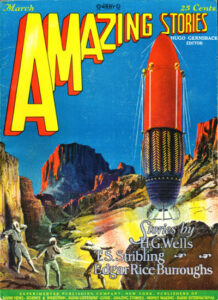
John Wyndham: Author of Day of the Triffids and Village of the Damned first encountered Science Fiction in 1929 when he found an issue of Amazing Stories left in a London hotel lounge. By February 1930 he sold his first story t0 Air Wonder Stories. Which was having a contest “Future Flying Fiction.
Lester Del Rey: In St. Charles Minnesota A friend loaned him the current issue in the fall of 1929 of The Science Wonder Quarterly. It featured a German SF novel translated into English by Otto Willi Gail’s The Shot Into Infinity.

L Sprague de Camp: Was older than most being introduced to the genre by his roommate at the California Institute of Technology. His roommate John D. Clark was a rocket fuel developer, chemist, and science fiction writer.
Judith Merril : In the early 40s her husband was a science fiction reader, but she wasn’t. During the winter she was ill in bed, so sick she missed an appointment with a dentist. She reached for something to read and grabbed two magazines. She remembered reading two stories that day. The Stolen Dormouse by L. Sprague de Camp appeared in the April and May issues of Astounding. Methuselah’s Children by Robert Heinlein was published in the July, August, and September issues of Astounding.
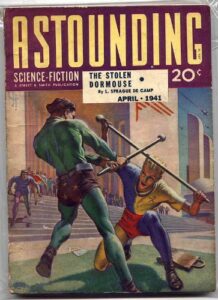
Catherine Lucille Moore: Born in Indianapolis on January 24, 1911, as a child Moore did a lot of reading due to being frequently ill. According to Moore herself, she was “reared on a diet of Greek mythology, Oz books, and Edgar Rice Burroughs.
Theodore Sturgeon: He and his brother were required to read in their stepfather’s library for 1 hour and a half each night. It is there he first read The Time Machine by H.G. Wells and Twenty Thousand Leagues under the Sea.
Philip Jose Farmer: Growing up in Peoria Illinois he was already reading Jules Verne and Edgar Rice Burroughs when he discovered the June 1929 issue of Science Wonder Stories. This 96-page pulp magazine edited by Hugo Gernsbeck featured The Diamond Maker by HG Wells.

Arthur C. Clarke: Discovered Amazing Stories in 1927 according to his autobiography. A specific issue is not mentioned. Soon after he bought a crate of Thrilling Wonder Stories for five cents a piece.
Do you know any I missed? Put it in the comments.
David Agranoff Grew up in Bloomington, Indiana hanging in the park that inspired this novel. His future wife worked at the Spoon serving the real-life Electric Fred. They have two of his notebooks and a house full of rescued animals. David is a novelist, screenwriter and a Horror and Science Fiction critic. He is the Splatterpunk and Wonderland book award nominated author of 11 books including the novels the WW II Vampire novel – The Last Night to Kill Nazis, and the science fiction novel Goddamn Killing Machines from CLASH BOOKS, The Cli-fi novel Ring of Fire, Punk Rock Ghost Story He co-wrote a novel Nightmare City (with Anthony Trevino) that he likes to pitch as The Wire if Clive Barker and Philip K Dick were on the writing staff. As a critic he has written more than a thousand book reviews on his blog Postcards from a Dying World which has recently become a podcast, featuring interviews with award-winning and bestselling authors such Stephen Graham Jones, Paul Tremblay, Alma Katsu and Josh Malerman. For the last five years David has co-hosted the Dickheads podcast, a deep-dive into the work of Philip K. Dick reviewing his novels in publication order as well as the history of Science Fiction. David’s non-fiction essays have appeared on Tor.com, NeoText and Cemetery Dance. He just finished writing a book, Unfinished PKD on the unpublished fragments and outlines of Philip K. Dick. He lives in San Diego where you can find him hooping in pick-up games and taking too many threes.




